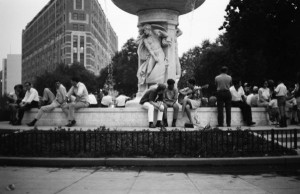Public Space & Commons
In the middle of Washington, DC lies a two-mile expanse of public space that stretches from the Capitol Building to the Lincoln Memorial. The diamond-shaped National Mall is a truly public space open to a wide variety of public activities. Art lovers can visit a dozen free museums that line the sides of the Mall. Several free movies a week can be seen at the National Gallery, the Hirschhorn, and the Freer. The Smithsonian puts on an annual Folklife Festival with craft demonstrations and several stages of free music that link far-flung cultural traditions, such as, in 2003, Scotland, Mali, and Appalachia.
Strollers on the mall can tour the 170 flower beds, the 35 ornamental pools and fountains, and, of course, the several memorials to individuals (Jefferson, FDR) and wars (Vietnam, Korea). During cherry blossom season, strollers can appreciate the delicate petals of the 3,000 trees circling the Tidal Basin. Joggers, frisbee players, kite flyers, Tai Chi practitioners, musicians, and afternoon nappers all take advantage of the space.
And protestors of all types converge on the National Mall to exercise their freedoms of assembly and speech. It was the site of Martin Luther King’s “I Have a Dream” speech in 1963, the huge anti-Vietnam War protests of 1971, the Million Man March of 1995, and the immense “March for Women’s Lives” in 2004.
Designed in the 18th century as a “grand avenue” and “place of general resort,” the Mall became crowded in the 19th century with soldier encampments during the Civil War and later a railroad depot at the foot of Capitol Hill. In the early 20th century, planners redesigned the space to be greener and more open to the public. In 2004, about 1.4 million people visited the Mall. This public space, while free for the visitors, is not cheap to maintain. The 2004 budget for the National Mall and the Memorial Parks was about $18 million. The federal government subsidizes the Smithsonian Institution — which administers many of the museums on the Mall — to the tune of half a billion dollars or 70 percent of the institution’s total budget.
There are few communities in the world that have or choose to spend the money to maintain as large and well-groomed a public space as the National Mall. The Mall is also somewhat of an anomaly in the United States, where cities and states have been cutting back on their funding for public space. Since the late 1970s, a wave of “privatization’” has led to cities handing public schools over to for-profit school management firms, the opening up of national parks to private developers, and the downscaling of public programs such as welfare. Advertising has appeared on “public” television, on the sides of “public” buses, and in the hallways of “public” schools.
The “commons,” enclosed in the agricultural sense many centuries ago to the advantage of private farmers, extends well beyond our usual definition of space. The commons can be understood as public space or national wealth or cultural heritage or global resources or virtual geography. In all these forms, though, the commons have been under attack. After a 1980 Supreme Court decision, biotechnology companies began to patent life forms, opening up the possibility for the transformation of public goods such as genetic material into private gain. “Intellectual property rights” have become a tool by which business have expanded their reach both geographically and conceptually.
Although forces of globalization have contributed to the transfer of public resources into private pockets – through the privatization of public utilities or the large-scale logging of tropical forests – a movement has also gained strength to defend the commons. The activities are diverse and cut across many realms of human experience. There have been protests to reclaim the streets. Tree-sitters have attempted to prevent logging. Open-source software developers have broken the computer monopolies. Generic drug production has made necessary medications available despite existing patents. Computer literacy trainings have spread the advantages of the Internet as widely as possible. And campaigns against big-box stores aim to keep local communities alive and thriving.
Who are the guardians of the commons? The state? The people? Civil society? When the commons are available to all, how do we prevent the looting of public goods by selfish individuals? How can societies prevent the kind of degradation of public space that was once so common in Soviet bloc countries? How can states go about raising “ceilings” with respect to standards connected to public goods without falling into the tendency to lower “floors”? Should advertising be considered a form of free speech, and can there be such a thing as useful advertising? How can we balance the need for just compensation for creators (of music, books, new plant varieties) with the need to spread the benefits of these innovations in a just manner throughout society?
On a trip to Provisions, pick up a copy of Sherene Razack’s Unmapping a White Settler Society to see how race and space converge, check out the irreverent Carbusters magazine from Prague, see how artist Krzysztof Wodiczko transforms public space with his art, visit the New York City Department of City Planning website to find all the cool spaces to hang out for free in the Big Apple, listen to the music of Negativland and their commentary on intellectual property, and watch Naomi Klein’s documentary version of her book No Logo.


